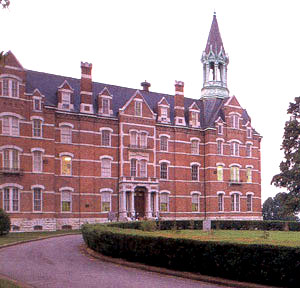
Jubilee Hall at Fisk University
Fisk Free School opened its doors in January 1866 in Nashville near what is today the site of Union Station. At the time, the campus's only buildings consisted of small, wooden hospital barracks originally built to serve Union soldiers who occupied Nashville during and after the Civil War.
By the early 1870s the wooden barracks were insufficient to serve the population of African Americans who wished to be educated at Fisk School. Through the efforts of Fisk's Jubilee Singers–who introduced Negro spirituals to the world beyond the South–funds were raised to relocate the school on more than forty acres of land in North Nashville.
Funds raised by the Jubilee Singers during an 1871-74 international concert tour were used to construct the school's first permanent building, Jubilee Hall. This imposing six-story building, named in honor of the Jubilee Singers, was designed by architect Steven D. Hatch of New York. Construction began in 1873 and was completed in 1876. The massive Victorian Gothic structure, which first housed the entire college, features a towering steeple. Complementary elements near the entrance are magnificent doors and a beautifully carved staircase created from wood sent from Sierra Leone, West Africa, by a former student.
In Jubilee Hall's first-floor Appleton Room hangs a floor-to-ceiling portrait of the original Jubilee Singers. The portrait was created by artist Edward Havell, portrait painter for the court of Queen Victoria, who commissioned this portrait in the 1880s and later presented it to Fisk University. The Appleton Room was totally refurbished in 1992 as a gift to the university from the William Randolph Hearst Foundation.
Jubilee Hall, dedicated in January 1876, is one of the oldest structures continuously in use for educational purposes by the African American community. Today, the six-story building serves as a residence for first-year female students. Over the years, as many as three generations of women in the same family–grandmother, mother, and daughter–have at different times occupied the same dormitory suite, making Jubilee Hall one of the most cherished buildings on the campus. Jubilee Hall has received recognition from the State of Tennessee in the form of a historical marker denoting the structure's significance. In 1976 the National Park Service designated Jubilee Hall as a National Historic Landmark.
Suggested Reading
Reavis L. Mitchell Jr., Fisk University Since 1866: Thy Loyal Children Make Their Way (1995)



